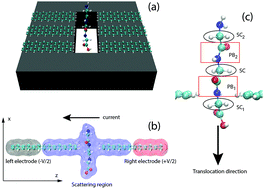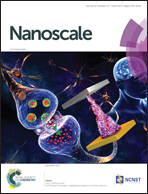Peptide bond detection via graphene nanogaps: a proof of principle study†
Abstract
Solid-state nanopores and nanogaps are emerging as promising tools for single molecule analysis. 2D materials, such as graphene, can potentially reach the spatial resolution needed for nucleic acid and protein sequencing. In the context of the density functional theory, atomistic modeling and non-equilibrium Green's function calculation, we show that glycine based polypeptide chains translocating across a nano-gap between two semi-infinite graphene nano-ribbons leave a specific transverse current signature for each peptide bond. The projected density of states and bond current analyses reveal a complex scenario with a role played by the adjacent α-carbons and side chains and by the orbitals of the partially resonant double bond involving C, N and O atoms of the peptide bond. In this context, specific fingerprints of the atoms involved in the peptide bonds are found. The same scenario is evidenced also for peptides involving alanine residues. The signal measured can be considered as a specific fingerprint of peptide bonds between small and neutral amino acids with no polar/charge effects. On this basis, a newly conceived nano-device made of a graphene based array of nano-gap is proposed as a possible route to approach peptide sequencing with atomic resolution.



 Please wait while we load your content...
Please wait while we load your content...